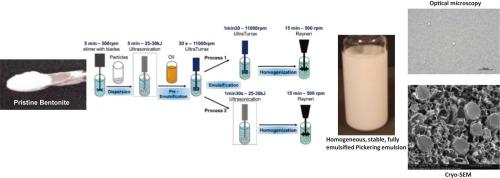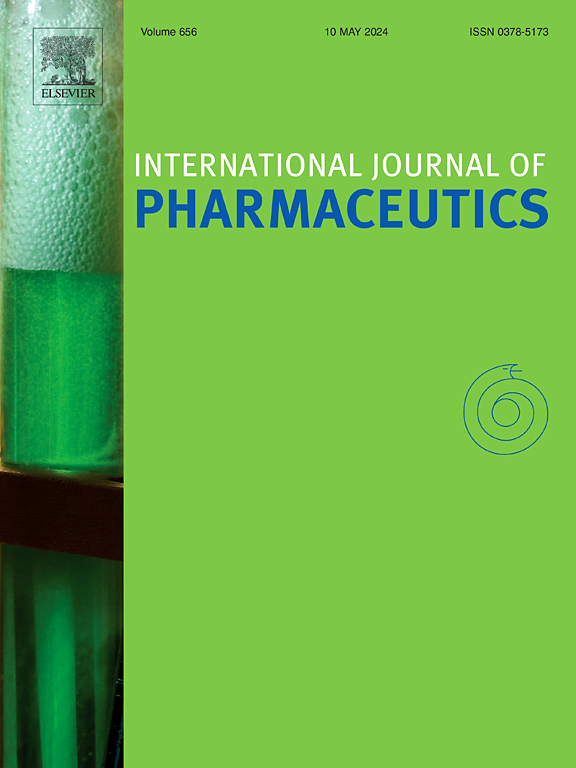未改性膨润土颗粒稳定酸洗乳的三个稳定水平:从颗粒效率到乳液稳定效率。
IF 5.2
2区 医学
Q1 PHARMACOLOGY & PHARMACY
引用次数: 0
摘要
当谈到皮克林乳液时,出现的第一个问题是颗粒在油/水界面定位的能力,然后确保形成的乳液稳定。然而,当我们试图将这种类型的乳液转化为工业需求时,例如,另一个问题出现了:颗粒的单独存在是否能够使我们获得稳定,均匀和完全乳化的乳液?我们已经能够证明,这是第一次,原始的膨润土颗粒,没有经历任何表面化学修饰,能够稳定乳液至少两年。为此,我们证明了乳化过程必须伴随着非常高的剪切。事实上,只有粒子受到高能超声(25-30 kJ)的过程才显示出这种高稳定能力。光谱学、表面自由能测量和微观表征证实,在这一阶段,这些原始的膨润土颗粒除了形态外保持不变。一个非常简单的配方,包含水,4 %的颗粒,20 %的癸酸/癸酸甘油三酯和1 %的防腐剂,已经证明它能够形成完全乳化,均匀和稳定的皮克林乳液。配方乳化液的流变学和微观测量清楚地表明,部分颗粒如预期的那样位于界面上,而且通过连续相中过量颗粒的3D网络组织,这种皮克林乳化液实现了均匀性和稳定性。我们的方法提供了一个强大的方法来解释随着时间的推移获得完全乳化和稳定的乳液的相关参数,使用原始的,未改性的,局部应用的膨润土颗粒。本文章由计算机程序翻译,如有差异,请以英文原文为准。

The three levels of stabilization in pickering emulsions stabilized by a non-modified bentonite particle: from particle efficiency to emulsion stabilization efficiency
When it comes to Pickering emulsions, the first question that arises is the ability of a particle to position itself at the oil/water interface and then ensure stabilization of the emulsion formed. However, when we try to transpose this type of emulsion to industrial requirements, for example, another question arises: can the sole presence of particles enable us to obtain stable, homogeneous and fully emulsified emulsions? We have been able to prove, for the first time, that pristine bentonite particles, which have not undergone any modification to their surface chemistry, are capable of stabilizing emulsions for at least two years. To this end, we have shown that the emulsification process must be accompanied by very high shear. In fact, only a process in which the particles were subjected to high-energy ultrasound (25–30 kJ) showed this high stabilization capacity. Spectroscopy, surface free energy measurement, and microscopic characterizations confirmed that at this stage these pristine bentonite particles remained unchanged, except for their morphology. A very simple formula containing water, 4 % particles, 20 % Caprylic/Capric Triglyceride and 1 % preservative has demonstrated its ability to form a fully emulsified, homogeneous and stable Pickering emulsion, Rheological and microscopic measurements of the formulated emulsion clearly show that part of the particles are positioned at the interface as expected and moreover that it is through the organization of a 3D network of particles present in excess in the continuous phase that this Pickering emulsion achieves both homogeneity and stability. Our methodology provides a robust approach for explaining the relevant parameters for obtaining a fully emulsified and stable emulsion over time, using pristine, non-modified, bentonite particles for topical applications.
求助全文
通过发布文献求助,成功后即可免费获取论文全文。
去求助
来源期刊
CiteScore
10.70
自引率
8.60%
发文量
951
审稿时长
72 days
期刊介绍:
The International Journal of Pharmaceutics is the third most cited journal in the "Pharmacy & Pharmacology" category out of 366 journals, being the true home for pharmaceutical scientists concerned with the physical, chemical and biological properties of devices and delivery systems for drugs, vaccines and biologicals, including their design, manufacture and evaluation. This includes evaluation of the properties of drugs, excipients such as surfactants and polymers and novel materials. The journal has special sections on pharmaceutical nanotechnology and personalized medicines, and publishes research papers, reviews, commentaries and letters to the editor as well as special issues.

 求助内容:
求助内容: 应助结果提醒方式:
应助结果提醒方式:


